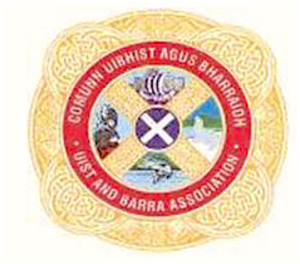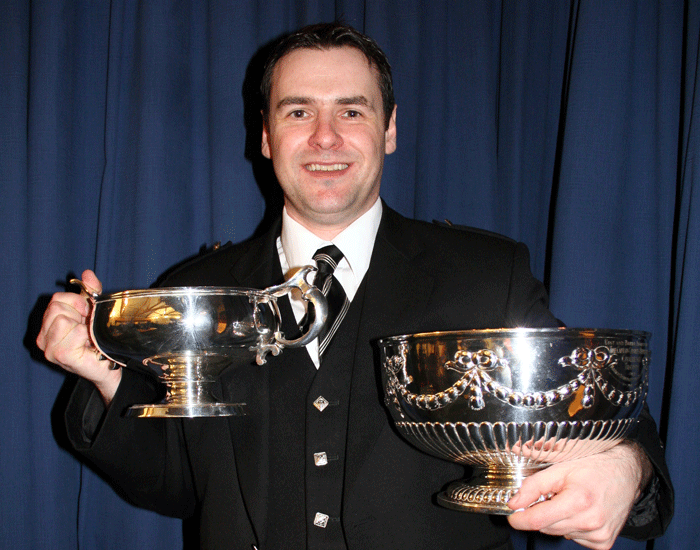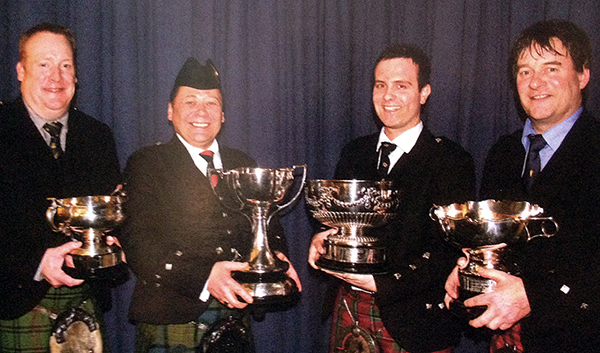 The first major professional competition of the year, the Uist & Barra, takes place in Glasgow on Saturday. Entry is £12; venue: College of Piping; date: March 4 at 9am. Pipers will compete in ceol mor, ceol beag and port grad-charach (hornpipe) and port cruinn (jig). Here is the running order and the tunes chosen by the committee for the pipers to play:
The first major professional competition of the year, the Uist & Barra, takes place in Glasgow on Saturday. Entry is £12; venue: College of Piping; date: March 4 at 9am. Pipers will compete in ceol mor, ceol beag and port grad-charach (hornpipe) and port cruinn (jig). Here is the running order and the tunes chosen by the committee for the pipers to play:
Ceol Mor:
1 Glenn Brown, Patrick Òg MacCrimmon’s Lament
2 Finlay Johnston, Craigellachie
3 Callum Beaumont, Lament for MacLeod of Colbeck
4 Faye Henderson, Colin Roy MacKenzie’s Lament
5 Roderick MacLeod, Old Men of the Shells
6 Craig Sutherland, Scarce of Fishing
7 Douglas Murray, In Praise of Morag
8 Wilson Brown, Bells of Perth
9 Jamie Forrester, Earl of Ross’s March
10 Niall Stewart, Stewart’s White Banner
11 William McCallum, Lament for the Earl of Antrim
12 Cameron Drummond, Unjust Incarceration

March, Strathspey & Reel/ Hornpipe & Jig
1 Wilson Brown, Taking of Beaumont Hamel, Piper’s Bonnet, Smith of Chilliechassie/ Arthur Gillies, Cailleach an Dudain
2 Craig Sutherland, Colin Thompson, Dora MacLeod, Loch Carron/ Man From Skye, John Patterson’s Mare
3 Niall Stewart, Kantara to El Arish, Pipe Major Hector MacLean, Mrs. MacPherson of Inveran/ Donald MacLeod, Skylark’s Ascension
4 Cameron Drummond, Lochaber Gathering, Caledonian Society of London, Broadford Bay/ Colin MacKay, Angus John MacNeil of Barra
5 Glenn Brown, Bonnie Ann, Caber Fèidh, Kalabakan/ Ina MacKenzie, Tenpenny Bit

6 Roderick MacLeod, Willie Gray’s Farewell to the Glasgow Police, Shepherd’s Crook, Ca’ the Ewes/ Piper’s Controversy, Donnie MacGregor
7 William McCallum, Braes of Brecklet, MacBeth’s Strathspey, Grey Bob/ Jim Tweedie’s Sea Legs, Braeriach
8 Jamie Forrester, Alan Dodd’s Farewell to Scotland, Arniston Castle, John Morrison of Assynt House/ Redondo Beach, Kenny Gillies of Portnalong
9 Callum Beaumont, Mrs. John MacColl, Inveraray Castle, Cockerel in the Creel/ Raigmore, Donella Beaton
10 Douglas Murray, Highland Wedding, Ewe wi’ the Crooked Horn, Alick C. MacGregor/ Crossing the Minch, Curlew
11 Finlay Johnston, Arthur Bignold of Lochrosque, Maggie Cameron, Sheepwife/ Train Journey North, Kenny MacDonald’s Jig
Pipers had to submit six of each in the ceol mor and MSR and four of each in the Hornpipe & Jig.
As we reported last time, the Uist and Barra annual piping competition started in 1944 after a sub-committee reported favourably on the feasibility of holding a professional contest. This sub-committee comprised of Roddy MacDonald (South Uist), Donald J MacLean (North Uist), Angus Morrison (South Uist) and Angus J MacDonald (North Uist). The first contest was held in the MacLellan Galleries, Glasgow, with ten leading pipers invited to compete. So successful was the event that the Association re-wrote its rules and constitution to make it an annual occurence.
Islanders resident in Glasgow were quick to donate trophies and the stature of the contest grew year on year. A decision to go ‘open’ led to a significant increase in entries (unfortunately not always of the required standard) and with the advent of grades by the Competing Pipers Association, A and B competitions were instituted. This helped with managing the numbers but through time the committee decided to revert to the invitational event that was the founders’ vision. The idea that invitational piping contests began with the Silver Chanter or the Glenfiddich is misplaced.
The venue for the contest has variously been the MacLellan Galleries, Glasgow High School, the Highlanders Institute, Smithycroft Secondary School near Barlinnie Prison, Henry Wood Hall, the National Piping Centre and now the College of Piping. Old U&B hands will tell of finals in the jigs going on until midnight, choruses of Gaelic songs as the pipers tune up and generous libations all round. The standard has always been among the best with music to the fore in the highest west coast tradition, particularly in the once common short leet system where pipers had to play twice over.
As the late convenor Ronald Morrison said, ‘This was when the finalists rose to the occasion and the audience got value for its money. Superb performances can be recalled from Ian McLellan, Strathclyde Police, Hector MacFadyen (Mull), Iain Morrison (Lewis), Capt John A MacLellan (Edinburgh Castle) and others too numerous to mention.’

In 1991 Scottish Television was anxious to gather evidence of its native credentials the better to impress the independent television licensing authorities in London and thus procure future broadcasting rights. To this end the Uist & Barra was filmed and the show broadcast in Gaelic to wide acclaim. Excerpts can be seen on the PP Video archive introduced by Angela MacEachan.
The income from this televising was used to increase prizemoney, however the presence of a cameraman and his assistant on stage during the playing was not to everyone’s taste. At times he got so close as to touch piper’s fingers with his lens cover. There were complaints from some pipers and Seumas MacNeill wrote a typically one-sided diatribe in the Piping Times magazine. This cannot have helped the cause of the future televising of piping events at that time, though technology, Livestream etc. has made this particular debate moribund. A rightly irritated Ronald Morrison wrote, ‘Strangely, the Uist and Barra competition had on many occasions received adverse criticism from this quarter; it would seem that a resentment arose if the competition was successful.’
Suffice to say that today the Uist & Barra competition upholds the finest traditions of its founding fathers and Saturday’s audience is guaranteed a day of excellent music and friendship.
















Recent Comments